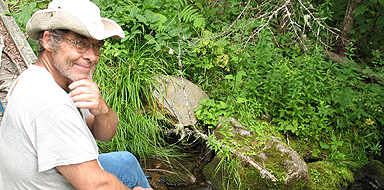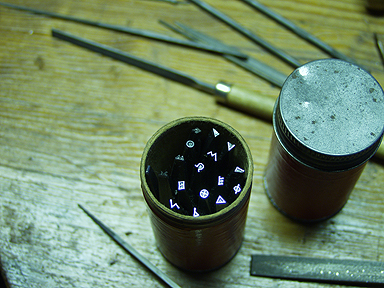
I will always associate Dan Carr, who died in June of 2012, with the shop he ran with Julia Ferrari, Golgonooza Letter Foundry & Press, in Ashuelot, New Hampshire. Ashuelot is a small town with a covered bridge, a fire department, and, but for Dan and Julia’s intervention, a proposed race course for ATVs. The shop was enormous, endless in my mind, because the walls could not be seen, its floor barely. At the start of any visit, after 45 minutes discussing politics, local to national and back to local, and more time admiring Bear and Mr. Clark, their two fine and ample cats, we would seek out unoccupied level space on which to place whatever nascent project of mine I wanted to show Dan. It would take another ten minutes to find a clearing, usually by shoving aside something I would have preferred looking at–a Spanish and English setting of poems by Pablo Neruda, a poem by Li Po printed from Chinese characters cast by Dan from recently discovered matrices, or even one of Dan’s own poems, exquisitely printed with Julia’s etchings on Japanese paper as a keepsake for friends. The endlessness, the boundless fascination of the space, every inch of it inhabited with textual and visual treasure, was essentially a simulacrum of Dan himself, a living memory palace. He was its tutelary deity. Whenever I saw him outside the shop, gracious as always, he somehow seemed a little bit out of place.
Dan was active in the Small Press Movement in the late 1960s and early ’70s. He contributed to and codirected the Four Zoas Press in Ware, Massachusetts, which published a poetry periodical called the Four Zoas Journal of Poetry and Letters, fusing Dan’s political and poetic concerns. Four Zoas took on typesetting and printing for other publishers to support its own projects. Dan and Julia founded Golgonooza Letter Foundry & Press in Boston in 1979, moving three years later to a large brick factory building in Ashuelot (population about 300). Golgonooza collaborated with the Limited Editions Club in New York on many book projects, including John Hersey’s Hiroshima, a selection of the poems of Frank O’Hara illustrated by Willem de Kooning, and a magnificent setting of Genesis with illustrations by Jacob Lawrence. These volumes are among the most beautiful and sought-after livres d’artistes created in the past 50 years.
I loved to touch all the metal in Dan’s shop–at least after it had cooled down a bit. Dan worked with metal in both molten and solid states. One area of the work floor was, in effect, a self-contained machine shop, with milling devices, pantographs, drill turrets, lathes, grinders, and benches with gravers, files, micrometers, and counterpunches. The metal of the machines was burnished from a history of long use that preceded Dan, but was always maintained with high precision, like the fine wood of a 17th century Cremonese violin. Dan knew his persnickety Monotype casters intimately and would interchange parts as needed–or machine his own pieces from blank stock. The casters produced characters from matrices with compressed air, dictated by a punched tape. The molten type metal (Dan had his favorite proprietary alloy formula) was pumped under pressure through a fine nozzle, while water kept things from overheating. There were more vents, passages, tubes, and moving parts in this assortment of contraptions than even a steam engine might have.
I’ve never known anyone so sensitive to type forms as Dan was. He explained how most digital fonts merely replicate smaller point sizes in larger forms, whereas type designers in the past would subtly rework founts to suit every variation in size. He knew the arcana of typographic history, and in a broadside he set and printed for me insisted that Nicholas Kis be properly credited for designing the type that usually bears Anton Janson’s name. Dan was a brilliant scholar of the written word, as his own translations of the eighth century Chinese poet Li Po (for which he taught himself Mandarin Chinese) amply show. So also his researches into the development of letterforms in archaic Greek–which led to his cutting a new Greek typeface, Parmenides–and into the history of printing from movable type in China, which anticipated Gutenberg by at least two centuries. Historical and aesthetic awareness informed his work: he spoke of the tradition of Aldus, Garamond, Fournier, Bodoni, and Baskerville as vital and ongoing. He reminded me, a bit obliquely, that Gutenberg died forgotten and poor, his noble pursuits only meagerly compensated

In Paris Dan studied the typographic art of punchcutting with French punchcutters Nelly Gable and Christian Paput, and was the only American ever awarded a diplôme de maître-graveur typographe. He brought to the process of punchcutting both his exquisite sensitivity to shape and form and extraordinary precision. No brain surgeon or concert violinist had anything on the control his hands displayed. Dan designed five typefaces–two for letterpress, Regulus and Parmenides; and three kinds of digital, Cheneau, Lyons, and Philosophie.
Dan’s love for poetry, music, most things Chinese, the environment, politics, art, printing machinery, and cats was of a piece. Dan was so invigorated by Howard Dean’s candidacy for the presidency in 2004–and conversely so offended by the folly of the presidential incumbent–that he decided to seek election to public office. He lost his first race for the New Hampshire state legislature–barely–but, undiscouraged, ran again in 2008 and won. I lent him some 36 line Gothic condensed wood type for his campaign posters; he joked that he was probably the only candidate for political office in the country whose lawn signs were printed letterpress from wood type. He surveyed the rocky political landscape of New Hampshire and decided that environmental legislation and Native American affairs were areas where his efforts would be most effective. He was almost completely lacking in cynicism and overt discouragement and believed in the possibilities of effective political engagement. As a political representative, and also as a teacher, Dan was giving and gentle, patient, both informed and informative, and never self-righteous.
Since I tended to be protective of Dan’s time, for the benefit of my own projects, I was more than a little bemused when Dan announced he was installing a new wood pellet heating system for shop and home, including a ten-ton outdoor hopper for fuel. He did much of the work himself, and I think it took him all of four months to complete. He was justly proud of what he’d done, but put other work aside, including mine, in order to finish the installation. So much of the world outside Dan and Julia’s shop demanded their attention, it’s remarkable he could still be so prolific as a poet, printer, typographer, designer, and publisher–though obviously I had to learn that some deadlines could never be met. I recognized genius in Dan, a term I may not be qualified to apply. The word’s derivation is associated with the attendant spirit of a person or place. Dan, with his skill, tools, and machinery, elegantly and indelibly impressed from metal to paper the voice of the word–of many, many words–in his books, typefaces, and poetry.
